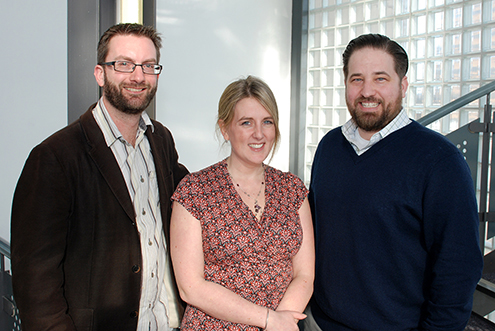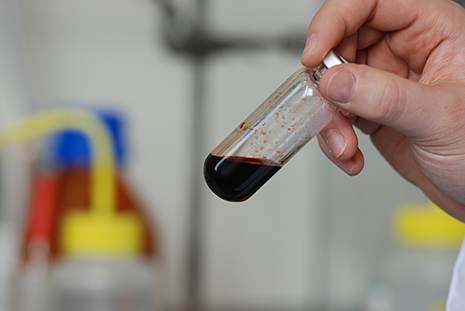New solar cells from light absorbing dyes harvest more energy

Mon, 13 Mar 2017 14:21:00 GMT
Key to the research is the use of synthetic chemistry to form light-absorbing dyes for solar cells, which harvest more energy, are more environmentally sustainable and economical to produce
 ► Pictured with Dr Elizabeth Gibson are Huddersfield chemists Dr Paul Elliott (left) and Dr Jason Camp
► Pictured with Dr Elizabeth Gibson are Huddersfield chemists Dr Paul Elliott (left) and Dr Jason Camp
TWO University of Huddersfield scientists are members of a team carrying out inter-disciplinary chemistry research aimed at the development of solar cells that are more efficient at harvesting the energy of the sun, while also being more environmentally sustainable and economical to produce than current devices.
A key to the research – described in a succession of new articles – is the use of synthetic chemistry to form light-absorbing dyes for solar cells.
“The majority of solar cells are based on crystalline silicon,” said the University of Huddersfield’s Dr Jason Camp, a member of the research group. As an organic chemist, he focuses on the development of organic dye molecules for dye-sensitized solar cells (DSSC) that can absorb light over the widest possible range of wavelengths.
 ◄ Final step in the synthesis of a solar cell dye
◄ Final step in the synthesis of a solar cell dye
“Unlike crystalline silicon, the new solar cells that are being developed can be printed on to flexible materials and are sensitive to low light levels. If you can absorb across the entire spectrum then you can convert more solar energy into electricity. The key now is to expand and refine that window. As synthetic chemists, we can do this much more easily with an organic dye because of the facile tunability of the photo-electronic properties,” said Dr Camp.
 ► Fluorescence in a solar cell dye precursor
► Fluorescence in a solar cell dye precursor
His co-researchers are the University of Huddersfield’s Dr Paul Elliott and physical chemist Dr Elizabeth Gibson, of Newcastle University’s School of Chemistry. Dr Elliott is an inorganic chemist who focuses on the photophysics of metal-containing organic compounds. The dyes produced at Huddersfield are then tested by Dr Gibson’s group, who are world experts in solar cell technology.
“Between the three of us we have expertise in organic, inorganic and physical chemistry, which gives us a broad platform to improve solar cell technology,” said Dr Elliott.
The ability to synthesise novel compounds for solar cell dyes at a molecular level, reducing dependence on scarce metals, could have considerable environmental benefits.
“One of the main issues with solar cells is that raw materials for them are limited in their current form so we need to look at other ways of harnessing light. We are looking at renewable sources for our starting materials,” said Dr Camp. “What is the point of having a really good solar cell if you have to use a rare metal that prevents you from rolling it out to the masses?”
Dr Gibson recently visited the University of Huddersfield to deliver a lecture titled Dye-Sensitized Photocathodes for Solar Energy Conversion and Storage, which focused on the recent advances in the field.
- New articles that describe recent research by Dr Camp, Dr Elliott, Dr Gibson and colleagues, include:
- Charge-transfer dynamics at the dye-semiconductor interface of photocathodes for solar energy applications in Faraday Discussions – DOI: 10.1039/C6FD00228E
- Resonance Raman Study of New Pyrrole-Anchoring Dyes for NiO-Sensitized Solar Cells in ChemPhysChem – DOI: 10.1002/cphc.201600846
- New cyclometalated iridium(III) dye chromophore complexes for p-type dye-sensitised solar cells in Dyes and Pigments – DOI:10.1016/j.dyepig.2017.01.011
- Investigation of a new bis(carboxylate)triazole-based anchoring ligand for dye-sensitised solar cell chromophore complexes in Dalton Transactions – DOI: 10.1039/C6DT02905A







